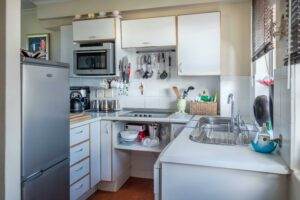Important note
- Safety first: Always unplug the refrigerator and shut off the water supply before any repair. Wear cut‑resistant gloves and eye protection.
- Warranty check: Many LG fridges carry extended coverage on major components. If your unit is still under warranty or you suspect a sealed-system/compressor issue, contact LG or a certified technician rather than attempting DIY.
- Scope: This guide covers safe, common homeowner fixes. Anything involving refrigerant lines, compressor replacement, brazing, or main board programming should be left to a pro.
What you’ll need
- Basic tools: Phillips screwdriver, flathead screwdriver, 1/4″ nut driver, needle‑nose pliers
- Cleaning: soft brush, coil brush, microfiber cloths, mild detergent, shop vacuum
- Diagnostics: multimeter (for continuity/voltage), infrared thermometer (optional)
- Defrost/thaw: turkey baster or squeeze bottle, warm water, hair dryer on low
- Parts and supplies: replacement water filter (correct LG type), replacement gaskets/fans/valves if needed, Teflon tape for water connections
Before you start: Quick setup and info
- Find your model number: Typically on the inner wall of the fridge compartment or behind the lower kick plate. You’ll need this for parts.
- Reset basics:
- Power cycle: Unplug for 5 minutes, then plug back in.
- Control lock: Make sure child lock isn’t enabled.
- Correct temps: Fridge 37–40°F (3–4°C). Freezer 0°F (-18°C).
- Smart features: If your model has LG ThinQ/Smart Diagnosis, run a quick diagnostic to capture error history and fan/compressor behavior.
- Clear the area: Pull the fridge forward to access the back and allow good ventilation.
How your fridge cools (in plain English)
- The compressor pushes refrigerant through coils to capture heat inside and dump it out the back/bottom.
- Fans move air over these coils and throughout the compartments.
- Sensors and a control board manage temperatures and automatic defrost cycles.
- When something goes wrong, it’s often fans, airflow, dirty coils, a blocked drain, an iced‑over evaporator, or a failing water-related component.
10-minute triage checklist
- Settings: Confirm temps, cooling mode on, and no demo/sabbath mode.
- Doors: Ensure they close smoothly, are level, and seals are intact and clean.
- Airflow: Don’t block interior vents with food. Leave space around the fridge for ventilation.
- Coils: Inspect and clean condenser coils (see below).
- Filter: Replace clogged water filter; air trapped after replacing can cause slow water flow—dispense for 2–3 minutes to purge.
- Sounds: Note any clicking (relay/overload), loud cycling, or fan grinding.
Symptom-by-symptom troubleshooting
1) Fridge not cooling or warming up
- Easy checks:
- Verify outlet power and breaker.
- Inspect and clean condenser coils.
- Ensure condenser fan (near compressor) is spinning when compressor runs.
- Check that doors seal firmly; replace damaged gaskets.
- Inside the fridge:
- Look for heavy frost on the rear panel of the freezer—often a sign of a defrost issue (heater, sensor, or control).
- Listen for the evaporator fan running when the door is closed (press and hold the door switch to test).
- What you can do:
- Clean coils and check/replace the condenser fan if not spinning.
- If the evaporator fan squeals, knocks, or doesn’t run, test/replace it.
- If the evaporator is encased in ice, fully defrost the unit (24–48 hours unplugged with doors open, towels down), then inspect the defrost drain and heater/sensor.
- Call a pro if:
- Compressor is hot and not running or you hear rapid clicking.
- Only one line of frost on the evaporator (possible sealed-system/refrigerant issue).
- The unit cools briefly after a reset and then warms again with compressor faults.
2) Freezer cold but refrigerator warm
- Likely causes: iced-over evaporator blocking airflow, failed evaporator fan, stuck/failed air damper, blocked vents by food.
- Fixes:
- Fully defrost the unit if you see ice buildup, then clear the defrost drain.
- Test evaporator fan; replace if noisy or nonfunctional.
- Ensure the damper door opens/closes; replace the damper if stuck.
3) Noisy operation (buzzing, grinding, rattling)
- Sources:
- Fan blades hitting ice (defrost issue).
- Condenser fan wobble or debris caught in it.
- Loose panels or water lines rattling against the back wall.
- Fixes:
- Defrost and remove ice, clear debris.
- Replace worn fan motors or bent blades.
- Add foam pad/tie-wrap to keep lines from vibrating against surfaces.
4) Ice maker not making ice
- Quick checks:
- Water filter age and type; replace if older than 6 months or flow is slow.
- Water pressure: Should be around 40–60 psi. Weak flow suggests a supply or valve issue.
- Door switches: If a door switch is faulty, the ice maker may not cycle.
- Common fixes:
- Thaw a frozen fill tube with warm water/hair dryer on low.
- Inspect/replace the water inlet valve if the ice maker won’t fill but the dispenser is fine (or vice versa).
- Run the ice maker’s test cycle if your model supports it; observe for fill and harvest.
- If the ice bin clumps:
- Dump and start fresh.
- Ensure the freezer is at 0°F (-18°C) and that the door closes tightly.
5) Water dispenser slow or not working
- Checks:
- Replace the water filter and purge air (dispense 2–3 minutes).
- Inspect the supply line for kinks.
- If temps are too low, the interior water line can freeze—raise fridge temp slightly.
- Fixes:
- Thaw frozen internal lines by warming the dispenser area from inside the fridge with the door closed (some models route lines through the door; be patient).
- Replace a failing water inlet valve if voltage is present but flow is weak.
6) Frost buildup, moisture, or “snow” in freezer
- Causes: warm air leaks (bad gasket, misaligned door), frequent long door openings, failed defrost, clogged drain.
- Fixes:
- Clean and reseat door gaskets; replace if torn. Warm new gaskets with a hair dryer to help them conform.
- Verify cabinet is level and doors self-close.
- Clear defrost drain (see steps below).
7) Leaking water under or inside the fridge
- Likely causes: clogged defrost drain, cracked drain pan, loose water connections.
- Fixes:
- Clear the defrost drain.
- Inspect the drain pan for cracks and proper seating.
- Reseat water lines; use Teflon tape where appropriate and don’t overtighten.
Targeted step-by-step repairs
A) Clean the condenser coils (improves cooling, reduces compressor strain)
- Unplug the fridge.
- Pull it out and remove the lower rear access panel if present.
- Use a coil brush and vacuum to remove dust from coils and around the condenser fan.
- Reinstall panel, plug back in, and allow 24 hours for temps to stabilize.
B) Replace a door gasket
- Identify the correct gasket for your model.
- Warm the new gasket with a hair dryer on low to relax folds.
- Pull the old gasket free; on some models it slides under a lip—on others screws hold a retainer—loosen, don’t remove, if needed.
- Seat the new gasket fully into the channel, working corners first.
- Close the door and check for uniform contact; adjust hinges or level feet if necessary.
C) Clear a clogged defrost drain (common cause of leaks and ice sheets)
- Unplug the fridge; remove freezer drawers/shelves.
- Take off the back interior panel (1/4″ screws) to access the evaporator area.
- Melt any visible ice with warm air and towels to catch water.
- Locate the drain hole beneath the evaporator; flush repeatedly with warm water using a turkey baster until it flows freely to the drain pan below.
- Reassemble and recheck after 24 hours.
D) Check and replace the evaporator fan (when fresh-food side is warm or there’s a squeal)
- Unplug the fridge; remove freezer back panel.
- Spin the fan by hand; if stiff/noisy, replace the motor and blade.
- Use a multimeter to check for power to the fan when the door switch is closed.
- Reassemble carefully to avoid rubbing blades.
E) Diagnose the water inlet valve (no/slow ice or water)
- Unplug and turn off water supply.
- Access the valve at the rear bottom.
- Inspect for cracks/mineral buildup.
- With a multimeter, check coil resistance against spec (varies by model).
- If the valve gets power during a dispense/fill command but doesn’t open, replace it.
Common LG error codes (general guidance)
- rF/FF: Refrigerator fan fault. Check/replace the evaporator fan in the fresh-food section.
- IF/1F: Ice maker fan fault. Inspect for ice blocking the fan; thaw and verify fan operation.
- dH/DE: Defrost issue. After a full manual defrost, check the defrost heater, thermostat/sensor, and wiring.
- FS/HS: Sensor errors. Inspect and replace the faulty thermistor/humidity sensor as needed.
Note: Clear codes by power cycling after the fix. If codes return, further diagnosis or board-level troubleshooting may be required.
When to call a professional
- Repeated warm temps with a very hot or silent compressor
- Single-line frost pattern on evaporator
- Strong refrigerant smells, oil under the unit, or visible damaged lines
- Burn marks on control boards or wiring, tripping breakers
- Units still under warranty or with known compressor coverage
Preventive maintenance checklist (5–10 minutes quarterly)
- Vacuum condenser coils and vent areas
- Confirm door seals are clean, springy, and gap-free
- Level the fridge so doors self-close
- Keep 2–3 inches of clearance around the cabinet
- Replace water filter every 6 months or per the indicator
- Verify temps: 37–40°F fridge, 0°F freezer
- Don’t overpack; keep vents clear for airflow
Parts and sourcing tips
- Always use your exact model number when ordering parts.
- Prioritize OEM or high-quality aftermarket parts with solid reviews.
- Take photos before disassembly so you can reassemble correctly.
Quick fixes at a glance
- Warm fridge: Clean coils, check fans, full manual defrost if iced over, verify seals and temps.
- No ice: Replace filter, check water pressure, thaw fill tube, test valve and ice maker cycle.
- Leaking: Clear defrost drain, inspect drain pan, secure water connections.
- Noisy: Remove ice from fans, replace noisy fan motors, secure rattling lines/panels.
Closing thought
Most LG refrigerator issues come down to airflow, ice buildup, or water flow—all solvable at home with patience and the right steps. Start with cleaning and simple tests, move to fan and valve checks, and call a pro for anything involving sealed-system or compressor work. With careful troubleshooting, you’ll often restore performance and add years to your fridge’s life. Additionally, it’s valuable to keep a list of refrigerator repair tips for common issues to reference whenever problems arise. Regular maintenance, such as defrosting and cleaning the condenser coils, can also prevent many common malfunctions. By being proactive and staying informed, you can ensure your refrigerator runs smoothly for years to come. If the issues persist despite your efforts, you may need to research how to fix refrigerator compressor problems specifically. Understanding the signs of a failing compressor can save you time and money, as it allows you to determine if a professional repair is necessary or if you can handle it yourself. Always prioritize safety by unplugging the refrigerator and ensuring all power sources are disconnected before attempting any repairs. Additionally, there are numerous online resources and tutorials that can provide detailed instructions on how to fix refrigerator cooling issues. Familiarizing yourself with these guides can empower you to tackle problems more confidently and efficiently. Remember, a well-maintained refrigerator not only operates better but also saves you money on energy bills in the long run.



